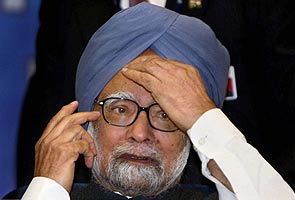
New Delhi, September 22: Prime Minister Manmohan Singh, in a televised speech this evening, explained to the nation the reforms introduced by his government last week. The PM said that the people have a right to know why his government took these decisions and that they should rest assured that the government did not want to burden the aam aadmi or common man.
Here are the political reactions to Dr Singh's speech:
Mamata Banerjee, Trinamool Congress Chief and West Bengal Chief Minister (on her Facebook page)
I want to ask what is the definition of aam aadmi? Is it not becoming clear that the use of the name of aam aadmi, and misuse of power of chair. Is it to finish aam aadmi? Is it the game plan.
Sitaram Yechury, CPI(M) leader
There is nothing new in the PM's speech
Kakoli Ghosh Dastidar, Trinamool Congress leader
PM is a gentleman, a learned man. But the Congress has no touch with the common man, though they keep talking about aam aadmi. Cut in subsidy will create problems for the middle class.
Mukhtar Abbas Naqvi, BJP leader
In his speech, the Prime Minister tried to mislead the country. He appeared advocating the interests of foreign countries and not the Indians, he leads.
Prakash Javadekar, BJP spokesperson
If PM wanted to show intent, he should have acted against corruption. Instead he has burdened the common man.
Tarun Vijay, BJP spokesperson
Money doesn't grow on trees, yes. Thanks for telling us, but money stashed in foreign banks? No mention of financial irregularities. Just Words.
Shivanand Tiwari, Janata Dal (United) spokesperson
Everybody knows that a major share of petrol and diesel is imported. But what steps has the government taken to bring down the consumption. He is accusing the Opposition of creating confusion on the issue but, in fact, Singh himself is doing so.
Prakash Karat, CPI(M) General Secretary
The Prime Minister has sought to defend the indefensible steps taken by the government. The Prime Minister has not answered how he could proceed with these measures when it does not have the support of the overwhelming majority in Parliament.
D Raja, CPI National Secretary
The address was very very desperate. He miserably failed to answer any questions raised by common man and parties.
Kapil Sibal, union minister
Without these decisions, our situation would have worsened. I think the steps taken are not much and are right. The steps in 1991 were opposed similarly.
Rashid Alvi, Congress spokesperson
The Prime Minister has explained each and everything as to why under the present circumstances, tough steps taken by the government were necessary. This should be appreciated by other parties.
Shabana Azmi, actor and activist
Sound speech by PM. There should be many such addresses to a bewildered nation so people know what's going on and why.
Ajay Maken, Union sports minister
PM shows strong resolve, aggression and focus for fast economic growth, for welfare of the common man! "Those opposing now, did so in 1991 too."
Adi Godrej, chairman of the Godrej Group and president of CII
A very balanced address, he clearly explained that these steps were very necessary. His comparison with 1991 was very apt. I am impressed with the action last week and today's speech; the government has good support. Mamata's pullout may strengthen the government - the stock market went up and the rupee appreciated. A stronger rupee will lead to lower inflation.
Jay Shankar, economist and political strategist
There is very little that the Prime Minister has to connect with the people... they don't know or understand great economic terminologies like fiscal deficit. He should speak to the people more often. In a typical democracy like India, regional parties have become strong and they determine how reforms should be implemented. Strong leadership is required.
Madan Sabnavis, chief economist, Care Ratings
The government should rethink its decision taken on subsidy. The PM spoke very good economics but was not convincing. It is not a precarious situation like in 1991, India is not the only country with a high fiscal deficit.
Kiran Mazumdar Shaw MD, Biocon
PM gave a very cogent explanation of the urgency for reforms. He reached out to the people to explain how he can't afford India to reach a situation like some European countries where people are losing their jobs. I wish he had done this earlier. We can't have a prime minister who keeps large periods of silence.





Comments
Add new comment